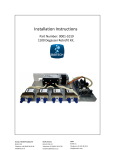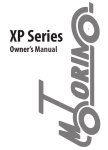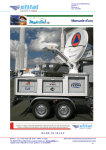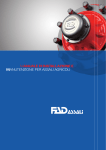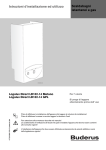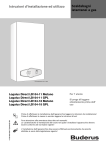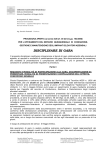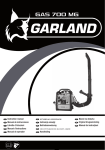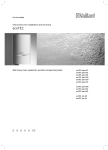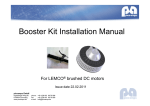Download Manuale d`installazione ed uso ITG 160Leggero
Transcript
italiano MANUALE D’USO E MANUTENZIONE MANUEL D’UTILISATION ET D’ENTRETIEN BEDIENUNGS-UND WARTUNGSANLEITUNG MANUAL DE USO Y MANUTENCIÒN ITG 160 Italian Top Gears s.r.l. ITG 160 rev. 01 Via G. B. Tiepolo, 21 31021 - Mogliano Veneto (TV) Via G. Falcone, 8 42020 - Borzano di Albinea - (RE) Italia Tel.: 0039 0522 350155 [email protected] - www.top-gears.it english OPERATION AND MAINTENANCE MANUAL italiano 03 02 01 Edizione originale - Original edition REV. PAGINE - SHEETS Marzo 2013 DATE - 1.3 - italiano INDICE 1. LETTERA ALLA CONSEGNA......................................................................... 1. 5 2. IDENTIFICAZIONE MACCHINA..................................................................... 1. 6 3. GARANZIA...................................................................................................... 1. 7 4. NOTE GENERALI ALLA CONSEGNA............................................................ 1. 8 5. AVVERTENZE PER LA SICUREZZA.............................................................. 1. 9 6. PRESCRIZIONI DI SICUREZZA..................................................................... 1. 10 7. CARATTERISTICHE TECNICHE.................................................................... 1. 13 8. TRASPORTO.................................................................................................. 1. 14 9. NOTE PER L'INSTALLAZIONE...................................................................... 1. 17 1. 21 9.1 ISTRUZIONE ROTAZIONE MOTORE 9.2 ISTRUZIONE MONTAGGIO ENCODER 9.3 LIVELLO OLIO 10. LUBRIFICAZIONE DEGLI ARGANI................................................................ 10.1 SOSTITUZIONE DELL’OLIO 10.2 CONTROLLO DEL LIVELLO DELL’OLIO 11. COLLEGAMENTI ELETTTRICI....................................................................... 1. 23 12. AVVIAMENTO DELL'ARGANO...................................................................... 1. 28 MANUTENZIONE........................................................................................... 1. 30 1. 34 13. 13.1 PREREGOLAZIONE DEL FRENO 13.2 REGOLAZIONE DEL FRENO 13.3 CONTROLLO DELLA CORSA 13.4 INTERVENTI DI MANUTENZIONE OBBLIGATORI 14. MANOVRA A MANO DI EMERGENZA.......................................................... 14.1 AVVERTENZE 14.2 ISTRUZIONI PER LA MANOVRA A MANO DI EMERGENZA - 1.4 italiano 1. LETTERA ALLA CONSEGNA applicabile. . 1.5 - italiano 2. IDENTIFICAZIONE MACCHINA Per qualsiasi comunicazione inerente ad una delle nostre unità di trazione, indicate sempre il numero di matricola e tenete a disposizione anche quelli Targhetta dati elettromagnete Targhetta motore Tipo macchina: Matricola: Ins. class: Riduzione: Tipo motore: Kw: Hz: A / RPM: Anno: F Encl. class: Cos f: V: F= Portata ventolam3/s: Made in I taly by I talian Top Gears s. r. l. - I TAL I A - 1.6 - IP 21 s/h Targhetta dati argano italiano 3. GARANZIA verificata ed ammessa dalla I.T.G. I.T.G. in porto franco. 3.3 L’eventuale richiesta di intervento tecnico da parte del Cliente deve essere inoltrata del Cliente. zioni: - I.T.G. al momento dell’ordine dell’unità di trazione e dalle condizioni d’impiego indicate sul catalogo tecnico I.T.G. e dal presente manuale; garanzia e della riparazione eseguita dal Cliente o disporrà per l’intervento dei propri Tecnici. 3.7.4 In ogni caso deve essere fornita l’intera documentazione fotografica delle sue macchine. 1.7 - Gli argani possono essere spediti su pallets o in casse. In ogni caso al ricevimento dell'argano controllare che: - l'imballaggio sia integro - la fornitura corrisponda alle specifiche dell'ordine (vedi bolla di accompagnamento o packing list) - non siano visibili danni all'argano o ai suoi accessori In caso di danni o di parti mancanti o danneggiate, informate tempestivamente la I.T.G., l’agente I.T.G. o il vettore che ha effettuato la consegna. I ricambi o le attrezzature in dotazione, quando necessario, vengono imballati in contenitori a parte. Motoriduttore completo di accessori secondo le specifiche dell'ordine Scheda dati macchina MANUALE D’USO E MANUTENZIONE italiano Manuale di istruzione MANUAL DE USO Y MANUTENCIÒN deutsch français ITG 160 english MANUEL D’UTILISATION ET D’ENTRETIEN english OPERATION AND MAINTENANCE MANUAL BEDIENUNGS-UND WARTUNGSANLEITUNG M L D’USO E M OPERATION AND M L D’ IONE AINTENANCE ANUAL SA ION ET D’ENTRETIEN G LEI G français W deutsch italiano 4. NOTE GENERALI ALLA CONSEGNA Italian Top Gears s.r.l. Via G. B. Tiepolo, 21 31021 - Mogliano Veneto (TV) Via G. Falcone, 8 42020 - Borzano di Albinea - (RE) Italia Tel.: 0039 0522 350155 [email protected] - www.top-gears.it Italian Top Gears s.r.l. ITG 160 rev. 01 ITG 134 - 135 - 136 rev. 01 - 1.8 Via G. B. Tiepolo, 21 Via G. B. Morgagni, 39 48028 - Lugo - (RA) Italia [email protected] - www.top-gears.it Scatola con pezzi di ricambio (se richiesta) italiano 5. AVVERTENZE PER LA SICUREZZA E’ responsabilità dell’installatore assicurare che l’installazione e la manutenzione siano svolte seguendo ogni necessario criterio e requisito per garantire la piena sicurezza e tutela della salute. L’installtore o manutentore deve osseravre e tenersi aggiornato in merito alle prescrizioni antinfortunistiche e agli obblighi legali per evitare danni alle persone o danni al prodotto durante l’installazione o la manutenzione e riparazione. Gli avvisi importanti ai fini della sicurezza e gli avvertimenti di periocolo sono posti in evidenza con i seguenti simboli. D Avvertimento di elevato rischio di pericolo (es.:zone di cesoiamento, zone di taglio, schiacciamento, etc.). Avvertimento generico di pericolo. Rischio di danno a parti del macchinario (per esempio dovuti ad una intallazione scorretta o simili). Simbolo per indicare ulteriori informazioni importanti. IN OCCASIONE DI QUESTE AVVERTENZE, PROCEDERE CON LA MASSIMA CAUTELA. Definizioni: - INSTALLATORE e/o MANUTENTORE : operatore qualificato riconosciuto come tale dal Cliente, autorizzato dal Cliente stesso ad intervenire sulla macchina per l’installazione e le operazioni di manutenzione. 1.9 . italiano 6. PRESCRIZIONI DI SICUREZZA ATTENZIONE Questo argano DEVE essere installato rigorosamente in un locale chiuso a chiave, il cui accesso è consentito esclusivamente al manutentore qualificato e autorizzato dal Cliente. Sulla porta di detto locale deve essere apposta la scritta con minimo quanto segue: MACCHINARIO PER ASCENSORE PERICOLO ACCESSO VIETATO ALLE PERSONE ESTRANEE AL SERVIZIO Il manutentore o l'installatore devono conoscere i pericoli connessi alla macchina e devono aver letto e compreso le istruzioni di sicurezza contenute in questo manuale. Prima dell'installazione dell'argano il Cliente deve verificare che la soletta, le strutture di sostegno dei carichi traslanti e dell'argano stesso, offrano i richiesti coefficienti di sicurezza. Il Cliente deve inoltre, rispettare la distanza da muri o da altre macchine secondo le direttive o norme del Paese dove l'argano verrà installato. SOLLEVAMENTO Per spostare l'argano (vedi anche “Trasporto“ Cap. 8) usare in sospensione i golfari del riduttore e una fascia non metallica intorno al motore, oppure con un carrello elevatore a forche di portata adeguata (vedi anche “caratteristiche tecniche” Cap. 7), sollevare l'argano al massimo 30 cm da terra e movimentarlo lentamente. - 1.10 a acchin Sala m italiano SCOLLEGAMENTO DA FONTI DI ENERGIA Prima di eseguire qualsiasi operazione di pulizia, lubrificazione e/o manutenzione, il manutentore deve mettere fuori servizio l'argano, escludendo l'alimentazione elettrica dello stesso e deve attendere che le zone riscaldate del motore e dell'argano stesso, raggiungano la temperatura ambiente. D ATTENZIONE D D Non appoggiarsi o sedersi sull'argano, sia quando questo è in esercizio, sia quando è disattivato. ATTENZIONE Non avvicinarsi o appoggiarsi alle parti rotanti (volano o puleggia verniciati in giallo). 1.11 - italiano Non depositare depositare oo appoggiare appoggiare oggetti oggettio ocontenitori contenitori Non liquidi ecc. ecc. sull'argano sull'arganoeeininmodo modoparticolare particolaresulle sulle didi liquidi partielettriche. elettriche. parti Non manomettere manomettere oo disinibire disinibire mai mai i i dispositivi dispositivididi Non sicurezza, né né creare creare by-pass, by-pass, néné utilizzarli utilizzarlia afinifini sicurezza, diversida daquelli quelliprefissati. prefissati. diversi Non manomettere manomettereoodeteriorare, deteriorare,né nérimuovere rimuovereleletarghette. targhette.InIncaso caso Non di deterioramento o constatazione illeggibilitàrichiedere richiederesubito subito di deterioramento o constatazione didiilleggibilità ITG alla il ricambio. alla ITG il ricambio. D L'installatore ed ed ilil manutentore, manutentore, inin prossimità prossimità L'installatore dell'argano NON NON DEVE DEVE MAI MAI INDOSSARE INDOSSARE dell'argano INDUMENTI SVOLAZZANTI SVOLAZZANTI E/O E/O LACERATI LACERATI (sciarpe, (sciarpe,foulard, foulard, INDUMENTI cappelli, collane, collane, cinturini, cinturini, orologi, orologi,braccialetti braccialettiaiaipolsi, polsi,anelli anellialle alle cappelli, dita ecc.). ecc.). dita 1.12 -- 1.12 Qui di seguito vengono riportate le quote di ingombro relative all’argano nella sua massima configurazione. Dati più dettagliati, quali: rapporto di riduzione, potenza assorbita, numero di poli del motore, ecc. si trovano nel catalogo tecnico ITG. 1.13 - italiano 7. CARATTERISTICHE TECNICHE italiano 8. TRASPORTO ATTENZIONE PERICOLO DI SCHIACCIAMENTO, URTO E ABRASIONE Il personale addetto alla movimentazione dell'argano deve aver letto le prescrizioni di sicurezza al paragrafo 6 di questo manuale deve indossare guanti da lavoro e scarpe antinfortunistiche. L'argano viene spedito dalla ITG in casse o su bancale avvolto da nylon. AVVERTENZA Non spostare mai le casse trascinandole, ma sollevandole. Non togliere la macchina dal suo imballo prima di averla collocata il più vicino possibile al punto di posizionamento definitivo. Per spostare la cassa servirsi di una gru a funi o di un carrello elevatore a forche lunghe di portata adeguata (vedi "caratteristiche tecniche" Cap. 7). Le forche, inoltre, devono essere posizionate larghe, in modo da evitare ribaltamenti. Qualora la macchina sia spedita su bancale, per la movimentazione con la gru utilizzare un bilancino di portata adeguata in modo che le funi o catene di sollevamento siano in verticale e non danneggino parti della macchina. - 1.14 italiano ATTENZIONE 1. Durante la movimentazione ricordarsi quanto segue: a. procedere lentamente b. non sollevare troppo la cassa da terra, salvo ostacoli, max 30 cm. c. la cassa deve essere appoggiata al suolo lentamente 2. Per le operazioni di disimballaggio iniziare dal lato superiore delle casse utilizzando mezzi di apertura appropriati. Dopo di chè, quando l'imballo è una cassa, togliere le pareti laterali, schiodandole in basso dal suo bancale. Quando la macchina è disimballata, NON DISPERDERE L'IMBALLO NELL'AMBIENTE, ma riutilizzarlo o destinarlo alle aziende di riciclo. 3. Tolte le pareti dell'imballo, controllare, con il documento di accompagnamento e con l'ordine, che la fornitura corrisponda all'ordine stesso. In caso di rilevata non corrispondenza con l'ordine, avvisare immediatamente la ITG o il suo Agente. Quando necessario comportarsi come descritto al paragrafo 4 "Note generali alla consegna". 4. Dopo aver imbragato l'argano, ma prima di sollevarlo, togliere le viti che lo fissano al bancale. 1.15 - italiano Nella movimentazione dell'argano disimballato, utilizzare una gru o un carrello a forche larghe di portata adeguata, utilizzando in sospensione il golfare del riduttore e una fascia non metallica attorno al motore. D ATTENZIONE Accertarsi che nel raggio di azione del mezzo di trasporto con l'argano (zona pericolosa) non vi siano persone esposte. In caso di lunghi periodi in deposito, lasciare l'argano sul suo bancale ed assicurarsi che sia sufficientemente protetto (almeno con un involucro impermeabile) in modo da evitare l'ossidazione di organi interni od esterni della macchina. Ricordarsi che l'ossidazione degli alberi o di altre parti meccaniche riduce la resistenza a fatica degli stessi. - 1.16 italiano 9. NOTE PER L'INSTALLAZIONE AVVERTENZA Il locale entro il quale viene installato l'argano deve avere le seguenti caratteristiche: - Deve essere asciutto e non polveroso: ciò è indispensabile per evitare corrosioni elettrochimiche delle parti meccaniche ed alta concentrazione d'acqua nell'olio di lubrificazione. (pulire il locale macchinario prima dell’installazione della macchina) - Deve essere ventilato: il locale deve avere adeguate aperture o condizioni per permettere un ricambio d'aria sufficiente a smaltire il calore ceduto dal motore elettrico e dal riduttore. - La temperatura del locale deve essere compresa tra i 5ºC ed i 40ºC. Per valori di temperatura diversi consultare la ITG. È fatto obbligo al Cliente di verificare che, dove l'argano verrà installato, l'impianto elettrico di rete presenti adeguata sezione dei cavi, corretta messa a terra e sufficiente potenza installata. 40°C OK 5°C 1.17 - italiano 9.1 ISTRUZIONE ROTAZIONE MOTORE Controdado ganasce Prima di procedere alla rotazione del motore è necessario: - leggere il capitolo “Prescrizioni di sicurezza”. - escludere l’alimentazione elettrica dell’argano. - Smontare gruppo puleggia. - Svitare i controdadi in modo da avere gioco tra ganasce e tamburo/volano. - Rimuovere le 4 viti di fissaggio M10x40 che collegano il gruppo motore con la carcassa argano. Argano orizzontale destro n° 4 viti M10X40 - Ruotare il gruppo motore facendolo girare in senso orario di 180° fino a quando i fori su cui prima erano inserite le viti non corrispondono con quelli posti sulla carcassa argano. - Riposizionare le 4 viti M10x40 e le corrispondenti grower. Serrarle con una coppia di 150 Nm. Nel caso in cui la rotazione del gruppo motore provochi interferenza tra la puleggia di trazione e la ventola, occorre procedere come segue: Argano verticale - Rimuovere la puleggia di trazione, svitando le tre viti M14x50 e tramite la stessa rondella avvitare le relative viti negli ulteriori fori filettati della puleggia interpondendo un blocco cilindrico come distanziale. Serrando le viti, la puleggia viene estratta. - Dopo avere ruotato il motore, montare la puleggia avendo cura di serrare le viti M14x50 alla coppia di 60 Nm ed utilizzando Loctite frenafiletti medio. Tre viti M14x50 - 1.18 italiano 9.2 ISTRUZIONE MONTAGGIO ENCODER Prima di procedere al montaggio dell’encoder è necessario: - leggere il capitolo “Prescrizioni di sicurezza”. - escludere l’alimentazione elettrica dell’argano. Se le macchine che vengono ordinate con predisposizione encoder sono fornite complete di tutti i componenti necessari per compiere tale operazione. La predisposizione standard prevede un perno di trascinamento encoder. - Svitare le viti che fissano la lamiera dell’encoder Lika C50. - Rimuovere la lamiera di fissaggio e sostituirla con quella fornita da ITG. - Rimuovere una delle 4 viti M8 di fissaggio della flangia secondo le indicazioni di figura. - Posizionare l’encoder facendolo scorrere coassialmente al perno fino a quando la piastrina non tocca la flangia reggispinta. - Riposizionare vite M8 facendola passare attraverso il foro diametro 9 della piastra e serrarla con una coppia di 25 Nm. - Serrare l’apposito grano di fissaggio encoder. Lamiera di Vite 1.19 - italiano 9.3 Livello olio Non rifornire mai la macchina con una quantità di olio superiore a quella raccomandata dalla ITG. In modo particolare a temperature elevate, una quantità di olio superiore a quella indicata, unitamente all’aumento della pressione interna, potrebbe causare danni alle tenute ed alle guarnizioni. - 1.20 italiano 10. LUBRIFICAZIONE DEGLI ARGANI Carico olio L'argano è fornito completo di olio sintetico. Fare attenzione che la vite di scarico sia ben chiusa. Per eventuali rabbocchi utilizzare solamente gli oli indicati sul tappo dell'argano: AGIP BLASIA S 220 Non usare altri tipi di oli! La quantità d'olio per gli argani ITG è di 6,0 litri 10.1 SOSTITUZIONE DELL' OLIO Consigliamo la prima sostituzione dell’olio dopo il primo anno di funzionamento per eliminare eventuali depositi generati nella prima fase di utilizzo dell’argano. Consigliamo la sostituzione ogni 3÷5 anni in relazione alle condizioni di utilizzo della macchina. Se la temperatura dell'olio supera gli 85°C (in caso di servizio intenso) la sostituzione dell'olio deve essere effettuata ogni 3 anni. La sostituzione dell'olio si rende anche necessaria nel caso di inquinamento dello stesso con altre sostanze (es. acqua o erronei rabbocchi con oli diversi da quelli indicati). Scarico olio Carico olio Per procedere alla sostituzione dell'olio si deve: - leggere il capitolo "Prescrizioni di sicurezza". - escludere l'alimentazione elettrica dell'argano. D - aspettare almeno trenta minuti dal fermo macchina per far raffreddare l’olio all’interno dell’argano. - pulire la zona intorno al tappo di carico olio dell'argano per evitare di introdurre al suo interno sporco o polveri, con possibili gravi danni per la macchina - togliere il tappo di carico dell'olio - posizionare sotto il tappo di scarico dell'olio un contenitore di recupero dell'olio esausto - svitare e togliere il tappo di scarico ed attendere qualche minuto finchè il serbatoio si sia svuotato interamente. Scarico olio 1.21 - italiano - pulire con uno straccio il tappo di scarico e le zone attorno alla sua sede; riavvitare il tappo facendo attenzione di rimontare anche la sua guarnizione; serrare a fondo. - pulire bene la superficie del contenitore dell'olio nuovo, del tappo di carico e delle zone prossime allo stesso per eliminare la possibilità di introdurre nell'argano dello sporco o residui di detriti. Il mancato rispetto di questa istruzione può provocare gravi danni alla macchina. - versare l'olio con un convogliatore pulito sino al raggiungimento del livello. - riposizionare il tappo di carico. NOTA Il tipo d'olio deve essere uguale a quello utilizzato in precedenza e come indicato nella presente istruzione. 10.2 LIVELLO DELL'OLIO Nella eventualità in cui si rilevasse insufficienza d'olio, provvedere ad un rabbocco con lo stesso tipo d'olio già presente dentro l'argano. Per il rabbocco seguire i punti descritti precedentemente. Il livello dell'olio deve essere controllato con la macchina ferma da almeno 30 min. ATTENZIONE L'olio esausto deve essere consegnato ad un'agenzia autorizzata al suo smaltimento. Non disperdere nell'ambiente. 1.22 italiano 11. COLLEGAMENTI ELETTRICI Prima di effettuare i collegamenti elettrici, l'installatore DEVE controllare che la tensione di rete corrisponda alle specifiche tecniche e ai dati riportati sulla targhetta del motore dell'argano. Tutte le connessioni elettriche devono essere effettuate con interruttore generale in posizione OFF. Essere sicuri che il voltaggio nominale di alimentazione sia sempre mantenuto. Se corrispondono si può procedere al collegamento del motore elettrico. 1 MOTORE ELETTRICO Con l'aiuto dello schema (che si trova inserito nella scatola della morsettiera del motore), eseguire il collegamento elettrico dello stesso facendo attenzione alla corretta connessione delle fasi e della terra. NOTA IMPORTANTE Gli eventuali termistori presenti nel motore DEVONO ESSERE COLLEGATI SOLAMENTE AD UNO SPECIFICO RELAIS. Il collegamento non corretto dei termistori fa bruciare gli stessi immediatamente. 2 SERVIZI Si procede al collegamento dei servizi seguendo lo schema elettrico riportato sotto il coperchio della morsettiera o in allegato al presente manuale. A collegamento eseguito chiudere la scatola della morsettiera. - In qualsiasi configurazione del motore collegare sempre la tensione 220 V~ ai morsetti 1,2 del ventilatore. 1.23 - italiano inglese MOTORI AC2 COLLEGAMENTO A STELLA L1 L2 L3 LINEA 3-FASE ALTA VELOCITA’ - 1.24 220 V~ Ventola Termistori L1 L2 L3 LINEA 3-FASE BASSA VELOCITA’ TERMOCONTATTI TERMISTORI 220 V ~ T < 150 °C 300 Ohm 1A T > 150 °C 4 KOhm COLLEGAMENTO BOBINE IN SERIE TERMISTORI 1W1 1V1 1U1 CENTRO STELLA 2W1 2V1 2U1 CENTRO STELLA GND 1W2 1V2 1U2 TERMOCONTATTI VENTOLA 2W2 2V2 2U2 Non applicare tensioni > 5 V ai terminali del Termistore + - Freno Italiano MOTORI AC2 COLLEGAMENTO A TRIANGOLO 1W2 1V2 1U2 2W1 2V1 2U1 1W1 1V1 1U1 COLLEGAMENTO BOBINE IN SERIE 2U2 TERMISTORI 2V2 TERMOCONTATTI VENTOLA 2W2 GND 220 V~ Ventola L1 L2 L3 LINEA 3-FASE ALTA VELOCITA’ TERMOCONTATTI Termistori + - Freno L1 L2 L3 LINEA 3-FASE BASSA VELOCITA’ TERMISTORI 220 V ~ T < 150 °C 300 Ohm 1A T > 150 °C 4 KOhm Non applicare tensioni > 5 V ai terminali del Termistore 1.25 - italiano MOTORE VVVF / COLLEGAMENTO STELLA 2V1 2U1 220 V~ Ventola L1 L2 Termistori L3 LINEA 3-FASE ALTA VELOCITA’ TERMOCONTATTI - 1.26 COLLEGAMENTO BOBINE IN SERIE 2W1 TERMISTORI 2V2 2U2 CENTRO STELLA GND 2W2 TERMOCONTATTI VENTOLA TERMISTORI 220 V ~ T < 150 °C 300 Ohm 1A T > 150 °C 4 KOhm Non applicare tensioni > 5 V ai terminali del Termistore + - Freno italiano MOTORE VVVF / COLLEGAMENTO TRIANGOLO 2W1 2V1 2U1 COLLEGAMENTO BOBINE IN SERIE 2U2 TERMISTORI 2V2 TERMOCONTATTI VENTOLA 2W2 GND 220 V~ Ventola L1 L2 Termistori + - Freno L3 LINEA 3-FASE ALTA VELOCITA’ TERMOCONTATTI TERMISTORI 220 V ~ T < 150 °C 300 Ohm 1A T > 150 °C 4 KOhm Non applicare tensioni > 5 V ai terminali del Termistore 1.27 - italiano 12. AVVIAMENTO DELL'ARGANO Prima di montare le funi sulla puleggia: - Verificare che il riduttore sia stato riempito d'olio. - Verificare che i collegamenti elettrici siano regolarmente effettuati e che le protezioni delle morsettiere siano state rimontate. - Dopo aver effettuato alcuni giri del volano a mano, avviare elettricamente il motore ad alta velocità per qualche secondo in un senso di marcia e, dopo una breve pausa, nell'altro. - Attendere qualche minuto (minimo 5 minuti) affinchè l'olio possa percorrere le canalizzazioni e lubrificare le parti rotanti. - Verificare la corretta apertura del freno come descritto nel foglio allegato all'argano. - Lasciare girare a vuoto la macchina per 3 ÷ 5 minuti ad alta velocità ed osservare che non emergano eventuali anomalie. In questo caso ricontrollare il collegamento elettrico, la tensione di alimentazione, le correnti assorbite e/o il bloccaggio dell'argano sulla sua base. In presenza di eventuali incertezze consultare la nostra organizzazione. - Verificare che la rotazione del volano avvenga sempre molto liberamente. Ripetere questa ultima operazione ancora una volta e ricontrollare. - Ciò fatto, montare le funi sulla puleggia e si effettuano le prime corse. - Verificare la corretta entità del contrappeso per non sovraccaricare l'argano ed il motore. AVVERTENZA Non far funzionare mai l'argano sotto carico con le viti di fissaggio della base non serrate! Si possono procurare gravi danni alla macchina! - 1.28 OK Durante le operazioni di montaggio dell'ascensore, non si deve far marciare l'argano per lunghi periodi in bassa velocità. Difatti, la marcia dell'argano in bassa velocità per lunghi periodi non permette la corretta lubrificazione dei supporti della macchina e può procurare grippaggi inattesi. Quindi, per assicurare la lubrificazione, è necessario avviare sempre l'argano a velocità di regime ad ogni inizio lavoro e, in seguito, eseguire una corsa in alta velocità ad intervalli di circa mezz'ora. AVVIAMENTO/ARRESTO Le procedure, le istruzioni e gli schemi per l'avviamento e l'arresto dell'argano sono a carico del Cliente. NON UTILIZZARE MAI L'ARGANO PER PRESTAZIONI CHE SUPERANO QUELLE INDICATE NEL CATALOGO TECNICO. SMALTIMENTO DELL’ARGANO PER FINE SERVIZIO Dopo aver svuotato la macchina dall'olio di lubrificazione: - Consegnare l'olio ad una ditta autorizzata al suo smaltimento. - Consegnare l'argano ad una ditta autorizzata al riciclo dei materiali ferrosi. 1.29 - italiano AVVERTENZA IMPORTANTE italiano 13. MANUTENZIONE Prima di effettuare qualsiasi operazione di manutenzione SI DEVE aver letto il paragrafo 6 "Prescrizioni di sicurezza" del presente manuale. Le operazioni di montaggio e/o manutenzione possono essere eseguite solo da addetti competenti, autorizzati ad accedere al macchinario e provvisti delle necessarie attrezzature e strumenti. ATTENZIONE Prima di iniziare le operazioni di montaggio e/o manutenzione occorre prestare attenzione alle prescrizioni di sicurezza riportate di seguito per evitare infortuni o di danneggiare la componentistica del prodotto: - Assicurarsi di disporre degli appropriati dispositivi di protezione individuale (elmetto, imbracatura, guanti, scarpe antinfortunistiche). - Assicurare sempre gli attrezzi ad eventuali oggetti per evitare cadute accidentali dall’alto. - Accertarsi che non vi sia tensione prima di operare sulle apparecchiature elettriche. - Installare l’impianto elettrico e/o collegamenti elettrici solo dopo aver letto le relative istruzioni. - Prima di iniziare l’installazione accertarsi sui limiti strutturali e spaziali nei quali verranno svolte le operazioni di montaggio / manutenzione. - E’ opportuno considerare dove, quando e con quali procedure di montaggio / manutenzione potrete o dovrete attivarvi. - E’ opportuno tener conto preventivamente di tutte le limitazioni rilevanti che riguardano le diverse fasi operative e di non iniziare ad agire senza prima averne valutato le conseguenze. L’installatore / manutentore deve prevedere un piano di manutenzione in relazione alle caratteristiche di utilizzo dell’argano. La manutenzione ordinaria dell'argano è limitata a: - Lubrificazione dell'argano (vedi pag. 1.14) - Pulizia generale dell'argano - Regolazione del freno - Valutazione stato di usura ferodi - Valutazione e verifica stato di usura gole puleggia - 1.30 italiano 13.1 PREREGOLAZIONE DEL FRENO Valori da impostare prima di installare le funi di sospensione dell’argano: - controllare che il freno non abbia subito danni durante il trasporto, - allentare il controdado (4), - regolare la molla mediante il relativo dado (3), - fissare la regolazione mediante il controdado (4), - per la regolazione della corsa vedi il rispettivo paragrafo. 4 3 NOTA: Ruotare il volano manualmente. “APERTO” “CHIUSO” “APERTO” 13.2 REGOLAZIONE DEL FRENO Il freno è provvisto di due magneti separati che rendono i ceppi indipendenti l’uno dall’altro. 1 2 5 6 5 2 1 13.2.1 REGOLAZIONE DELLA CORSA - Allentare i controdadi (2) di entrambi i ceppi freno e svitare la vite di regolazione (1) lasciando un gioco di 4-5 mm fra la vite ed il perno elettromagnete (5), - girare la leva aprifreno (6) nella posizione “aperto”, - avvitare le viti di regolazione (1) manualmente fino a mandarle a battuta del perno elettromagnete (5), - girare la leva aprifreno (6) nella posizione “chiuso” e avvitare la vite di regolazione per mezzo giro contro il perno elettromagnete, - bloccare i controdadi (2). 13.2.2 CONTROLLO DELLA REGOLAZIONE Azionare la cabina su e giù e osservare la rumorosità. La corsa è corretta se il ferodo non tocca sul tamburo freno mentre l’ascensore è in movimento e se non si rilevano rumori alla frenata. Vel. Elevatore [m/sec] Spazio di Frenatura [cm] alto basso 9 11 17 23 14 19 29 52 74 130 36 64 92 163 1.31 - italiano L=66,5mm 13.2.3 REGOLAZIONE DEL MOMENTO FRENANTE 3 L’esecuzione non corretta della presente procedura può pregiudicare il corretto funzionamento del sistema frenante. Il momento frenante si regola a cabina vuota (i valori sono riportati nella tabella). Ripetere la medesime operazioni per entrambe le ganasce: Assicurarsi che il dado (7) sia ben serrato sulla flangia. Svitare il contro dado di bloccaggio (4). Controllare lo spazio di frenata. Se lo spazio di frenata è troppo breve allentare la molla mediante il dado (3). Se risulta troppo lungo stringere la molla sempre mediante il dado (3). - Regolato correttamente lo spazio di frenata, controllare che le molle abbiano la stessa estensione. - Fissare la regolazione tramite il contro dado (4). 4 - 7 1 5 6 13.3 CONTROLLO DELLA CORSA - Accertarsi che la leva aprifreno (6) sia in posizione centrale (freno chiuso). Premere manualmente il perno elettromagnete (5) fino in fondo e quindi misurare il gioco tra la vite di regolazione (1) e il perno elettromagnete (5). Se tale gioco dovesse risultare < 0,5 mm, la corsa dovrà essere regolata immediatamente. Tipo Macchina - 1.32 D ( Ø Tamburo freno ) [mm] Coppia massima frenante Coefficiente di attrito del ferodo 5 1 italiano 13.4 INTERVENTI DI MANUTENZIONE OBBLIGATORI Gm Verifica Periodicità livello olio 4 mesi spessore delle guarnizioni dei freni 4 mesi regolazione dell'apertura delle ganasce freno 2 mesi stato di usura delle gole della puleggia 6 mesi (acustica) dello stato dei cuscinetti 6 mesi (acustica) delle eventuali presenze di rumorosità anomale 6 mesi del gioco assunto dall'ingranaggio misurato nelle condizioni indicate in figura. (assicurandosi prima che non esistano giochi assiali della vite) 12 mesi Rp G = Gm Rpr Rp Gm Rpr Rp = raggio primitivo della corona = raggio della puleggia = misura del gioco della puleggia R.R. R.R. 45/1 55/1 43/2 Quando il gioco dell’ingranaggio “G” supera il valore di “ G* ”, indicato di seguito, l’ingranaggio deve essere sostituito perché non offre più la necessaria sicurezza. Rpr [mm] Rpr [mm] 134,95 133, 8 135,0 Rapporto di riduzione Rapporto di riduzione G* (mm) G* (mm) 45/1 0,80 0,62 55/1 0,75 0,51 43/2 0,80 0,50 1.33 - italiano 14. MANOVRA A MANO DI EMERGENZA 14.1 AVVERTENZE La manovra a mano di emergenza è un’operazione pericolosa. Essa permette il movimento della cabina escludendo tutti i contatti di sicurezza dell’impianto. E’ quindi necessario che chi effettua tale manovra sia stato opportunamente addestrato da personale specializzato e deve essere consapevole dei rischi che ne derivano. L’assistenza in caso di emergenza deve essere effettuata solamente da personale esperto e addestrato in modo specifico. Tutte le operazioni svolte in caso di emergenza devono seguire scrupolosamente le indicazioni presenti in questo manuale. Pertanto una copia di questo documento deve essere conservata in prossimità del deposito e facilmente reperibile in casi di necessità. Nel caso di manovra a mano di emergenza rispettare rigorosamente le seguenti indicazioni: 1. Seguire le prescrizioni locali di sicurezza. 2. Non trascurare in alcun modo la sicurezza dei passeggeri. 3. Non procurare rischi a se stessi in nessun caso. 4. Assicurarsi che le proprie azioni non creino situazioni pericolose per terzi. 5. Le comunicazioni con eventuali passeggeri presenti in cabina devono essere stabilite nel minor tempo possibile in modo da rassicurare le persone presenti. Questa operazione può aiutare nello stabilire con maggior precisione la posizione della cabina nel vano. 6. Prima di ogni intervento comunicare preventivamente come si intende agire ai passeggeri. 7. Ad intervento ultimato assicurarsi che non permangano problemi per il funzionamento normale dell’impianto. 14.2 ISTRUZIONI PER LA MANOVRA A MANO DI EMERGENZA La manovra a mano di emergenza è un’operazione pericolosa Essa permette il movimento della cabina escludendo tutti i contatti di sicurezza dell’impianto. E’ quindi necessario che chi effettua tale manovra sia stato opportunamente addestrato da personale specializzato e deve essere consapevole dei rischi che ne derivano. d - 1.34 Per una corretta manovra a mano di emergenza attenersi scrupolosamente alle seguenti istruzioni. I passeggeri non devono assolutamente forzare le porte di cabina o cercare di uscire dalla stessa. Non allentare mai la tensione delle molle del freno con lo scopo di facilitare la manovra a mano di emergenza. FRENO ATTIVO (ganasce freno chiuse) FRENO INATTIVO (ganasce freno aperte) POS 1 POS 2 5. Accertarsi che le condizioni operative del freno principale e dell’argano siano sicure per la movimentazione della cabina. Per verificare l’efficienza del freno principale dell’argano valutare: - se esistono rotture alle ganasce freno - se i ferodi presentano dei danneggiamenti che ne limitano la superficie di contatto - se il contatto con la superficie frenante è uniforme 6. Controllare il senso di rotazione dell’argano per la manovra di movimentazione della cabina. Qualora l’argano e/o il freno principale siano fuori uso o ci sia il paracadute inserito eseguire la procedura di soccorso assicurando la cabina utilizzando un’attrezzatura specifica adatta alla tipologia di impianto, al luogo e alle condizioni di lavoro. 7. Bloccare manualmente la rotazione del volano dell’argano. 8. Rilasciare il freno principale agendo sull’apposita leva manuale (POS 2). 9. Iniziare la manovra a mano per portare la cabina al piano di destinazione, ruotando manualmente il volano nella direzione più favorevole. 10. Rilasciare la leva manuale di sblocco del freno principale dell’argano verificando che ritorni nella posizione di riposo (POS 1). 11. Aprire le porte di cabina ed assistere i passeggeri. 12. Chiudere le porte di cabina e di piano. 13. Controllare che tutte le porte di piano siano chiuse e che non si possano in alcun modo aprire. 1.35 - italiano 1. Controllare che tutte le porte di piano siano chiuse e che non si possano in alcun modo aprire. 2. Controllare se la cabina è al piano, altrimenti procedere come di seguito. 3. Posizionare l’interruttore generale in posizione OFF posto all’interno del quadro di manovra. 4. Rassicurare i passeggeri in cabina ed informare su come si intende procedere. inglese 03 02 01 REV. ĚŝnjŝŽŶĞŽƌŝŐŝŶĂůĞͲKƌŝŐŝŶĂůĞĚŝƟŶŐ Edizione originale - Original editing PAGINE - SHEETS March 2013 DATE - 1.3 - inglese 03 02 01 REV. ĚŝnjŝŽŶĞŽƌŝŐŝŶĂůĞͲKƌŝŐŝŶĂůĞĚŝƟŶŐ Edizione originale - Original editing PAGINE - SHEETS March 2013 DATE - 1.3 - inglese TA BLE OF CONTENTS 1. LETTER UPON DELIVERY ................................................................................ 1. 5 2. MACHINE IDENTIFICATION ........................................................................................ 3. WARRANTY...................................................................................................... 1. 7 4. GENERAL NOTES UPON DELIVERY............................................................ 1. 5. SAFETY WARNINGS ................................................................................... 1. 9 6. SAFETY PROVISIONS ................................................................................. 1. 10 7. TECHNICAL FEATURES ............................................................. .................. 1. 13 8. TRANSPORT AND HANDLING...................................................................... 1. 14 9. INSTALLATION PROVISIONS ...................................................................... 1. 17 1. 21 1. 6 8 9.1 MOTOR ROTATION INSTRUCTIONS 9.2 ENCODER FITTING INSTRUCTIONS 9.3 OIL LEVEL 10. HOSTING MACHINE LUBRICATION 10.1 OIL REPLACEMENT 10.2 OIL LEVEL CONTROL 11. ELECTRIC CONNECTIONS ......................................................................... 1. 23 12. FIRST OPERATION OF THE HOISTING MACHINE ........................................................ 1. 28 MAINTENANCE........................................................................................... 1. 30 1. 34 13. 13.1 BRAKE PRE ADJUSTMENT 13.2 BRAKE ADJUSTMENT 13.3 CHECKING THE BRAKE STROKE 13.4 MANDATORY MAINTENANCE OPERATIONS 14. EMERGENCY MANUAL OPERATION 14.1 WARNINGS 14.2 INSTRUCTIONS FORT THE EMERGENCY MANUAL OPERATION - 1.4 1. LETTER UPON DELIVERY The I.T.G. gearboxes have been designed and manufactured accordingly to the 98/37/CE ed EN12100-1, EN12100-2 ed EN12100-3 norms and fulfiling the applicadevices will be kept in the due efficiency. The Company I.T.G. compliments you for choosing its products and is sure that you will achieve the best possible performance from them.prestazioni. . 1.5 - inglese Dear Customer, inglese 2. MACHINE IDENTIFICATION always indicate its serial number and have available also the data of the brake electromagnet and of the electric motor, which are all easily traceable thanks to the specific plates on the machine. Motor data plate Electromagnet data plate Machine plate - 1.6 - 3. WARRANTY inglese 31.1 The warranty, unless other contractual arrangements, is governed by the following clauses: dispatch from its premises. In that period, ITG will take over the replacement of any and accepted by ITG. 3.2 The parts under warranty for repair or replacement, must be delivered to ITG on DDU basis. may apply: - The drive unit or its component parts have been subject to tampering; of use stated on the ITG technical catalogue and in this manual; seals. - me or transport. 3.7 Procedures for warranty repair: occurance of the defect, by e-mail or by fax; 3.7.1 I.T.G. shall confirm by e-mail or fax the possible acceptance of the warranty claim - 3.7.3 In no event I.T.G. recognizes charges for warranty repairs that were not approved in advance by itself. reasons and for enabling ITG to correct and improve the quality and reliability of its machines. 1.7 - 4. GENERAL NOTES UPON DELIVERY - Always check that the machine complies with the given specifications by checking the transport documents - Also verify that no transport damages have occurred to the machine or its accessories. In case of damages or of damaged or missing parts, please timely inform ITG, the ITG Agent and the forwarder who has handled the delivery. The spare part or accessories, are normally delivered in separated boxes. Complete hoisting machine delilvered as for the order Machine specifications form MANUALE D’USO E MANUTENZIONE italiano Instruction manual MANUAL DE USO Y MANUTENCIÒN ITG 160 français english MANUEL D’UTILISATION ET D’ENTRETIEN english OPERATION AND MAINTENANCE MANUAL BEDIENUNGS-UND WARTUNGSANLEITUNG deutsch inglese The machines can be delivered either on pallets or into wooden boxes. In any case, when receiving the machine, always inspect the crating and verify its integrity. Italian Top Gears s.r.l. Via G. B. Tiepolo, 21 31021 - Mogliano Veneto (TV) ITG 160 rev. 01 - 1.8 Via G. Falcone, 8 42020 - Borzano di Albinea - (RE) Italia Tel.: 0039 0522 350155 [email protected] - www.top-gears.it Individual box for spare parts or accessories (whether applicable) Making sure that the installation and the maintenance are performed based on the essential safety heath care conditions is responsibility of the Installer. The installer and the Maintenance operator must operate strictly following the safety regulations and must respect any legal obligation for avoiding damages to the people or to the product during the installation, the routinary maintenance and the repair of the machine. Safety warnings and danger advices are highlighted by the following symbols. D Warning of high risk of danger (eg, shear zones, zones of cutting, crushing, etc.) Generic danger warning Risk of damage to part of the machine (for instance due to uncorrect installation or similar occurrencies). Symbol indicating important notices When meeting these warnings, please proceed with great diligence and attention. Definitions: - INSTALLER and/or MAINTENANCE OPERATOR Qualified Operator authorised by the Customer to perform the installation or the maintenance of the machines. . 1.9 - inglese 5. SAFETY WARNINGS 6. SAFETY PROVISIONS WARNING! inglese This machine must be installed in a locked room and only the Technical people authorised by the Customer can be allowed to enter in it. ELEVATOR MACHINE DANGER. ENTRANCE FORBIDDEN TO ANY NON AUTHORISED PERSON Installers or maintenance personnel must be aware of the dangers associated with the machine and must have read and understood the safety precautions in this manual. Before installing the hoisting machine, the Customer must verify that the concrete slab and/or the support structures of the shifting loads and the winch meet the required safety factors. The Customer MUST also respect the distances from walls and from other machines in accordance with the directives and standards in force in the Country where the machine will be installed. LIFTING - 1.10 To move the hoisting machine (see Chap. 8 Moving the machine) use a lifting system connected to the eyebolts on the hoisting machine and a non-metallic strap wrapped around the motor, or use an adequately sized forklift (see Chap 7 - Technical features) to lift the winch a maximum of 30 cm off the floor and move the machine slowly. a acchin Sala m EXCLUSION OF POWER SOURCES inglese Before carrying out any cleaning, lubrication and/or maintenance operation, maintenance personnel must put the winch out of service by disconnecting the power supply and must wait for the heated parts of the motor and the winch to reach ambient temperature. inglese D WARNING D D Do not lean and/or sit on the winch, either when it is in or out of service. WARNING Do not approach or lean against the rotating parts (flywheel or rotatating parts painted in yellow). 1.11 - inglese Do not deposit or place any object or containers of liquids etc. on the hoisting machine and especially on the electrical parts. Never tamper with or disable the safety devices or by- pass them or use them for purposes other than those for which they were intended. Do not tamper with or damage or remove the number plates. If deteriorated or illegible, immediately ask ITG for replacement. D - 1.12 When working near the winch, Installers and maintenance operators MUST NEVER WEAR FLAPPING AND/OR TORN CLOTHING (scarves, ties, hats, necklaces, belts, watches, bracelets, rings, etc...). 7. TECHNICAL FEATURS inglese Here are the overall dimensions of the hosting machine. More detailed data, such as: reduction ratio, absorbed power, number of poles in motor, etc. can be found in ITG Technical Catalogue. 1.13 - inglese 8. TRANSPORT AND HANDLING WARNING RISK OF CRUSHING, IMPACT AND ABRASION The personnel who are responsible for handling the winch must have read the safety requirements in paragraph 6 of this manual and must wear work gloves and safety shoes. The winch is shipped by ITG in crates or on pallet wrapped by plastic film. WARNING Never move the crates by dragging them. Always lift them. Before removing the machine from its packing, place it as near as possible to its final position. To move the crate, use a crane with ropes or an adequately sized forklift with long forks (see Chap. 7 “Technical features”). Furthermore, the forks must be positioned far apart to avoid flipping over. If the machine has been shipped on a pallet, use an adequately sized load spreader when moving with a crane so that the lifting cables or chains are kept in a vertical position and do not damage parts of the machine. - 1.14 WARNING inglese 1. During handling, remember the following points: a. proceed slowly b. do not lift the crate more than 30 cm off the ground unless obstacles are present c. lay the crate on the ground slowly When unpacking the create, start from the top and use a lever. 2. 3. When unpacking the create, start from the top and use a lever. Once the walls of the crate have been removed, check that the supply corresponds with the shipping document and the order. If it does not correspond with the order, immediately notify ITG or it Agent. If necessary, proceed as described in paragraph 4 “General delivery notes”. 4. After slinging the hoisting machine, remove the screws retaining it to the pallet before lifting it. 1.15 - inglese When moving the unpacked hoisting machine, use a crane or an adequately sized forklift with wide forks and a suspension-type lifting system connected to the eyebolts on the traction unit and a non-metallic strap wrapped around the motor. D WARNING Make sure that nobody is within the operating range of the means of transport (danger zone). If the machine is stored for long periods, leave it on its pallet and make sure it is adequately protected (at least with a waterproof covering) to prevent oxidation of the internal or external parts of the machine. Remember that oxidation of the shafts or other mechanical parts reduces their fatigue strength. - 1.16 9. INSTALLATION PROVISIONS WARNING inglese The room where the traction unit is installed must have the following characteristics: - It must be dry and free of dust: this is essential to prevent electrochemical corrosion of mechanical parts and a high concentration of water in the lubricating oil (clean the machine room before installing the machine). - The room must be ventilated: the room must have adequate openings or conditions that allow air circulation which dissi- pates the heat from the motor and the reduction unit. 40°C - The room temperature must be between 5 °C and 40 °C. For other temperatures, contact ITG. - For positioning of the vent plug, refer to Chapter 9.3. The customer has to make sure that the electrical system to which the machine is about to be installed has suitably gauged cables, is correctly earthed and adequate power is installed. OK 5°C 1.17 - 9.1 MOTOR ROTATION INSTRUCTIONS Brake arm fixing nut Before proceeding with the rotation of the motor it is necessary: inglese - to read the chapter “Safety Provisions”; - disconnect the machine from the power supply; - remove the traction sheave; - release the brake arm fixing nut so to have air between the brake shoes and the brake drum; Horizontal right machine n° 4 screws M10X40 - remove the four M10x40 screws reataining the motor cluster to the gearbox case; - rotatate the motor cluster clockwise by 180°, until the holes where the four screwsd were fit match the other ones of the gearbox case; - reposition the 4 M10x40 screws and their correponding growers. Lock by applying the torque of 25 Nm; Whether the rotatation of of ther motor cluster would produce interference between the traction sheave and the motor cooling fan, it is then necessary to proceed as it follows: Vertical machine - remove the traction sheave by releasing the three M14x50 screws and using the same washer screw the three bolts in the additional holes located on the traction sheave hub, having care to interpose a cilindic block as a spacer. The shave is pulled out by locking the screws. After having rotated the motor cluster, install once again the traction sheave, having care to lock the M14x50 screws by appplying the torque of 60 Nm and using thread locking mild Loctite. Three M14x50 screws - 1.18 9.2 ENCODER FITTING INSTRUCTIONS inglese Before proceeding with the instalaltion of the encoder it is necessary to read the Chapter “Safety Provisions”. Then disconnect the electrical power supply to the winch. If machines are ordered with the encoder option, they are supplied with all the parts needed to perform this task. The standard option includes an encoder driving pin. - Unscrew the screws that fasten the Lika C50 encoder plate. - Remove the retaining plate and replace it with the one supplied by ITG. - Remove one of the fastening screws on the flange as shown in the diagram. - Put the encoder in position by sliding it coaxially until the plate touches the thrust bearing flange. - Put the screw back in place by inserting it in the hole in the plate and tighten it to a torque of 25 Nm. Detail of winch with encoder option - Tighten the specially supplied encoder fastening dowel. Fixing plate Screw 1.19 - 9.3 Oil level inglese inglese Never fill the machine with a quantity oil above that recommended by ITG. Especially at high temperatures, an higher quantity of oil than stated, together with the increase of internal pressure, could cause damage to seals and gaskets. - 1.20 10. HOISTING MACHINE LUBRICATION inglese Oil filling plug The hoisting machine is supplied filled with polyglycole synthetic oil. Please make sure that the drian plug is well tightened. For eventual refill, please use only the ITG reccomended oils. AGIP BLASIA S 220 Do not use other oils! The oil quantity for the ITG hoisting machines is 3,5 liters! Oil draining plug 10.1 We reccomend the first complet replacement of the oil after the first year of operation of the hoisting machine, for eliminating eventual depots produced in the first stage of functioning of the machine. We suggest to entirely replace the oil after 3/5 years depending on the working conditions of the machine. If the oil temperature raises above 85° (in case of heavy duty) the oil has to be mandatorily replaced every three years. The replacement of the oil is also required in case of pollution with other substances (ie. water or refills with different oils than the ITG reccomended ones). Oil filling plug For replacing the oil it is necessary to: - To read the chapter “Safety Provisions” - To disconnect the machine from the power feeding. D - To wait at least thirty minutes after having stopped the machine and let the oil temperature decrease -To clean the area sorrounding the drain plug of the machine so to make sure not to allow dust to enter into the machine main case; Oil draining plug - remove the oil drain plug; - put a container under the drain plug in order to collect the exhausted oil; - to release and remove the drain plug and wait for a few minutes, until the oil has totally drained out from the machine. 1.21 - inglese clean the drain plug and the area where it is housed with a cloth; tighten the plug and make sure you also insert the washer; tightly fasten. - thoroughly clean the surface of the new oil container, the filler cap and the area surrounding it to prevent dirt or deposits entering the winch. Failure to comply with these instructions may cause serious damage to the machine. - pour the oil through a clean spout until the level on the transparent gauge is reached. - replace the filler cap. WARNING The used oil must be given to a firm that is authorised to dispose of it. Do not release into the environment. PLEASE NOTE The oil has to be the same as the type previously used and indicated in these instructions. 10.2 OIL LEVEL If the oil level is low, top up using the same type of oil that is in the hoisting machine. To top up, follow the above steps. The oil level must be checked when the machine has been off for at least 30 minutes. WARNING The used oil must be given to a firm that is authorised to dispose of it. Do not release into the environment. 1.22 Inglese 11. ELECTRICAL CONNECTIONS Before arranging the electrical connections, installers MUST make sure that the mains voltage matches the technical specifications and and the data on the machine identification plate. All electrical connections must be made with the main switch in the OFF position Make sure that the rated supply voltage is maintained at all times. If they match, connect the electric motor. 1 ELECTRIC MOTOR Using the wiring diagram (which can be found in the motor terminal box), make the electrical connections and make sure that you connect the phases and earth correctly. IMPORTANT NOTE Any thermistors on the motor MUST BE CONNECTED TO A SPECIFIC RELAY ONLY. Incorrect connection of the thermistors will burn them out immediately. 2 AUXILIARIES Connect any auxiliaries by referring to the wiring diagram placed under the terminal box cover or enclosed with this manual. After connecting, close the terminal box. 1.23 - inglese AC2 MOTOR STAR CONNECTION L1 L2 L3 LINEA 3-FASE ALTA VELOCITA’ TERMOCONTATTI - 1.24 COLLEGAMENTO BOBINE IN SERIE TERMISTORI 1W1 1V1 1U1 CENTRO STELLA 2W1 2V1 2U1 CENTRO STELLA GND 1W2 1V2 1U2 TERMOCONTATTI VENTOLA 2W2 2V2 2U2 220 V~ Ventola Termistori + L1 L2 L3 LINEA 3-FASE BASSA VELOCITA’ TERMISTORI 220 V ~ T < 150 °C 300 Ohm 1A T > 150 °C 4 KOhm Do not apply tension > 5 V to termistors terminals Non applicare tensioni > 5 V ai terminali del Termistore - Freno inglese AC2 MOTOR DELTA CONNECTION 1W2 1V2 1U2 2W1 2V1 2U1 1W1 1V1 1U1 COLLEGAMENTO BOBINE IN SERIE 2U2 TERMISTORI 2V2 TERMOCONTATTI VENTOLA 2W2 GND 220 V~ Ventola L1 L2 L3 LINEA 3-FASE ALTA VELOCITA’ TERMISTORI 220 V ~ T < 150 °C 300 Ohm T > 150 °C + - Freno L1 L2 L3 LINEA 3-FASE BASSA VELOCITA’ TERMOCONTATTI 1A Termistori 4 KOhm Do not apply tension > 5 V to termistors terminals Non applicare tensioni > 5 V ai terminali del Termistore 1.25 - inglese VVVF MOTOR STAR CONNECTION 2V1 COLLEGAMENTO BOBINE IN SERIE 2W1 TERMISTORI 2V2 2U2 TERMOCONTATTI VENTOLA 2W2 GND CENTRO STELLA inglese 2U1 220 V~ Ventola L1 L2 Termistori + L3 LINEA 3-FASE ALTA VELOCITA’ TERMOCONTATTI - 1.26 TERMISTORI 220 V ~ T < 150 °C 300 Ohm 1A T > 150 °C 4 KOhm Do not apply tension > 5 V to termistors terminals Non applicare tensioni > 5 V ai terminali del Termistore - Freno inglese VVVF MOTOR DELTA CONNECTION 2W1 2V1 2U1 COLLEGAMENTO BOBINE IN SERIE 2U2 TERMISTORI 2V2 TERMOCONTATTI VENTOLA 2W2 GND 220 V~ Ventola L1 L2 Termistori + - Freno L3 LINEA 3-FASE ALTA VELOCITA’ TERMOCONTATTI TERMISTORI 220 V ~ T < 150 °C 300 Ohm 1A T > 150 °C 4 KOhm Do not apply tension > 5 V to termistors terminals Non applicare tensioni > 5 V ai terminali del Termistore 1.27 - 12. STARTING THE MACHINE inglese Before placing the cables on the pulley: - Make sure that the reduction unit has been filled with oil. - Check that the electric connections have been made correctly and that the terminal box covers have been put back into position. - After turning the flywheel a few turns by hand, start the motor at high speed for a few seconds in one direction and then, after a short pause, in the other. - Wait a few minutes (5 minutes minimum) for the oil to flow along the channels and lubricate the rotating parts. - Make sure the brake releases correctly as described in the sheet enclosed with the winch. - Run the machine without load for 3 ÷ 5 minutes at high speed and make sure no anomalies occur. If malfunctioning occurs, recheck the electrical connection, supply voltage, absorbed current and/or the way the winch is clamped to its base. If you are uncertain about anything, contact ITG. - Make sure that the flywheel always turns freely. Repeat the last step and recheck. - At this point, place the cables on the pulley and perform the first operations. - Make sure that the counterweight is the correct size and does not overload the winch and the motor. WARNING Never operate the winch under load when the base fastening bolts are not tight! This may cause serious damage to the machine! - 1.28 OK iMPORTANT inglese When installing the lift, do not operate the winch for long periods at low speed. When the winch operates for long periods at low speed, the machine supports are not lubri- cated properly and may seize up unexpectedly. To ensure proper lubrication, always start the winch at normal operating speed each time work is begun and then run at high speed every half an hour. START-UP/SHUTDOWN The customer is responsible for the procedures, instructions and wiring diagrams for the start-up and shutdown of the winch. NEVER USE THE HOISTING MACHINE FOR PERFORMANCES ABOVE THOSE INDICATED IN THE TECHNICAL CATALOGUE. DISPOSAL OF THE WINCH AT THE END IF ITS SERVICE LIFE Drain the machine of its lubricating oil and then: - Deliver the oil to a company that is authorised to dispose of it. - Deliver the winch to a company that is authorised to recycle ferrous materials. 1.29 - 13.1 BRAKE PRE ADJUSTEMENT 3 - check that the brake hasn’t been hurt during transport or installation; - release the fixing nut (4); - adjust the spring acting of the nut 3; - fix the adjustment by acting of the nut 4; - to adjust the stroke, please read the related chapter. NOTE: manually turn the flywheel “OPEN” 13.2 BRAKE ADJUSTMENT The brake is provided of two separated magnets that makesd the brake arms independed one from eachother. 1 2 “CLOSED” 5 6 “OPEN” 5 2 1 13.2.1 STROKE ADJUSTMENT - Release the fixing bolts (2) of both the brake arms and release the adjusting screw (1) leaving a gap of 4-5 mm between the screw and the pivot of the magnet; - rotate the brake opening lever (6) to the “open” position; - manualy screw in the the adjusting screws (1) until they reach the pivot of the magnet; - rotate the brake opening lever (1) to the “closed” position and screw in by half a turn the adjusting screw toweards the magnet pivot; - block the fixing nuts (2). 13.2.2 CHEKING THE ADJUSTMENT Run the elevator upwards and downwards and verify the noise level. The stroke is correctly adjusted is the brake liner doesn’t touch the brake drum while the elevator is running and if there is no noise during braking operations. Elevator speed [m/sec] Braking distance [cm] High 9 14 19 29 52 74 130 Low 11 17 23 36 64 92 163 1.31 - inglese 4 Values to be set before installing the ropes on the traction sheave of the hoisitng machine: 13. MAINTENANCE inglese Before carrying out any maintenance work, MAKE SURE YOU HAVE read chapter 6 “Safety provisions” of this manual. Operations of installation and/or maintenance can be done only by competent personnel, authorised to access the machinery and having the necessary equipment and instruments. WARNING Before starting any installation and/or maintenance work, you must pay attention to the safety requirements shown below in order to avoid accidents and damage to the product components: - Make sure you have the appropriate personal protection equipment (helmet, body harness, gloves, safety shoes). - Always secure equipment and other objects to avoid them accidentally falling from a height. - Make sure that the power has been disconnected before working on electrical equipment. - Only install the electrical system and/or the connections once you have read the relative instructions. - Before starting installation, see if there are any structural and space limitations where the installation/ maintenance work will be carried out. - It is advisable to consider where and when you will operating and which assembly/maintenance pro- cedures you will use. - Take account beforehand of all significant limitations that may regard the various operation phases and do not start work without first evaluating the consequences. Installers/maintenance personnel must provide a maintenance plan in relation to the use characteristics of the hoisting machine. Routine maintenance of the winch is limited to: - Lubrication of the hoisting machine (see page 1.14) - General cleaning of the traction unit - Brake adjustment - Assessment of wear and tear of brake linings - Assessment and checking of wear and tear of pulley grooves. - 1.30 L=66,5mm 13.2.3 ADJUSTING THE BRAKING TORQUE 3 inglese If this procedure is not correctly performed, it may result in the incorrect operation of the braking system. The braking torque is adjusted when the car is empty (values are indicated in the table). Repeat the same steps for both brake shoes: 4 - Make sure that the nut (7) is tightly fastened on the flange. - Unscrew the check nut (4). - Check the braking distance. - If the braking distance is too short, loosen the spring by turning the nut (3). If it is too long, tighten the spring again by turning the nut (3). - Once the braking distance has been adjusted correctly, check that the springs are of the same length. - Secure the adjustment using the locknut (4). 7 1 5 6 13.3 CHECKING THE STROKE Make sure that the brake opening lever (6) is in central position (brake closed). Manually press the electromagnet pivot (5) down to the end of its stroke and then measure the clearance between the adjusting screw (1) and the electromagnet pivot (5). If it is < 0.5 mm, the stroke must be immediately adjusted. Tipo Macchina - 1.32 D ( Ø Tamburo freno ) [mm] Coppia massima frenante Coefficiente di attrito del ferodo 5 1 13.4 COMPULSORY MAINTENANCE OPERATIONS Gm Frequency livello olio 4 mesi Thickness of brake linings 4 mesi Adjustment of the brake shoes opening Wear and tear of traction sheave grooves 2 mesi (acoustic) of condition of bearings 6 mesi inglese VERIFY 6 mesi (acoustic) of presence of abnormal noise levels backlash on gear measured as shown in the figure. 6 mesi 12 mesi Rp G = Gm Rpr Rp Gm Rpr Rp = Primitive radius of the crown wheel = traction sheave radius = measurement of the traction sheave clearance R.R. R.R. 45/1 55/1 43/2 When the “G” gear backlash exceeds value “ G* ”, indicated below, the gear must be replaced because it no longer offers the required level of safety. Rpr [mm] Rpr [mm] 134,95 133, 8 135,0 Reduction ratio G* (mm) G* (mm) 45/1 0,80 0,62 55/1 0,75 0,51 43/2 0,80 0,50 0,56 1.33 - 14. OPERATING THE EMERGENCY MANUAL MANOUVRE 14.1 WARNING inglese The manual emergency operation can be dangerous. It allows the movement of the cabin by excluding any safety contact of the plant. It is therefore necessary that who perfoms the manouvre has been opportunely trained by specialised personnel and has to be aware of the implied risks. Assistance in the event of an emergency must only be provided by expert, specially trained personnel. All the operations performed in the event of an emergency must strictly follow the instructions in this manual. A copy of this document must therefore be kept near the area where the winch is stored and must be easily accessed if necessary. When performing manual emergency operating, strictly observe these instructions: 1. Follow local safety requirements. 2. Do not neglect the safety of passengers at risk in any way. 3. Do not put them at risk in any way. 4. Make sure that their actions do not create hazardous situations for third parties. 5. Communication with any passengers in the cab must be established as soon as possible in order to reassure the people present. This can help to establish the position of the cab in the well more pre- cisely. 6. Before each intervention, first inform the passengers of what you intend to do. 7. After completion of work, make sure there are no problems with normal operating of the plant. 14.2 INSTRUCTION FOR OPERATING THE EMERGENCY MANUAL MANOUVRE The manual emergency manouvre is a dangerous operation! Essa permette il movimento della cabina escludendo tutti i contatti di sicurezza dell’impianto. E’ quindi necessario che chi effettua tale manovra sia stato opportunamente addestrato da personale specializzato e deve essere consapevole dei rischi che ne derivano. D - 1.34 For the correct performance of emergency manual manouvre, please carefully follow these instructions. 3. 3. Put the main switch on the control panel to the OFF position. 4. 4. Reassure the passengers in the car and inform them dabout what you are about to do. Passengers must not try to forcedly open the car doors or try to get out of it. Never operate in such a manner to reduce the tension on the brake springs in order to make the emergency manouvre easier ENGAGED BRAKE (brake shoes closed) NOT ENGAGED BRAKE (open brake shoes) POS 1 POS 2 5. Before doing it, please check that the operating conditions of the main brake and of the hoisting machine are safe for moving the car. To check if the main brake on the machine is working properly, please check: - if the brake shoes are broken; - if the brake linings have damage which limits the contact surface; - if contact with the braking surface is even. 6. Check the direction of rotation of the winch for moving the car. Whether the winch and/or the main brake are out of use or the safety is on, perform the rescue procedure and ensure that the car is secure by using a special device suitable for thetype of plant, place and operating conditions. 7. Manually block rotation of the flywheel of the machine. 8. Release the main brake using the special manual lever (POS 2). 9. Begin manual operating to move the cab to the required floor by manually rotating the flywheel in the right direction. 10. Release the manual release lever of the 11. Open the cabin doors and help the passengers. 12. Close the cabin and floor doors. 13. Check that all the floor doors are closed and that they cannot be opened in any way. Never loosen the tension of the brake springs to make manual emergency operating easier. BRAKE OFF (brake shoes open) POS 2 BRAKE ON (brake shoes closed) POS 1 1.35 - inglese 1. Check that all the floor doors are closed and that they cannot be opened in any way. Check that the car is at 2. floor level. If it is not, do the following. 2100100100160 REVISIONE 0 MARZO 2013








































































